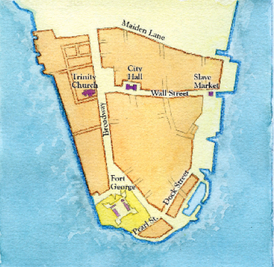Slave Revolt of 1712
In the early 1700s, New York had one of the largest slave populations of any of England’s colonies. One out of every five New York residents was enslaved.
Slavery in New York differed from some of the colonies because there were no large plantations. Many of the enslaved Africans were skilled workers, carpenters, stone masons, fishermen, and boat builders.
These slaves lived and worked next to free and indentured whites, and some intermarried when they got their freedom.
No one knows for certain what caused the revolt that happened the night of April 6, 1712, but this much is known: Between 20 and 70 armed Africans set fire to a building. When white settlers tried to put out the fire, they were attacked, resulting in the death of nine whites and injury to eight others.
Militia units from Westchester and lower New York put down the insurrection. Seventy slaves and free blacks were jailed and 43 were put on trial. Eighteen were acquitted and 25 convicted, resulting in 20 being hanged and three burned at the stake.
This uprising resulted in the passage of even tougher slave codes by the New York State legislature, giving slave owners great leeway in meting out punishment to enslaved Africans.
This entry contributed by
Curriculum Concepts International
Related Media
Images

|
Maiden Lane once included an orchard, where enslaved Africans and two Native Americans met to plan the rebellion. Today the lane is part of downtown’s financial district.
|

|
On the night of April 6, 1712, a large well-planned and violent uprising began on Maiden Lane, which at that time ran along the northern edge of the city.
|
